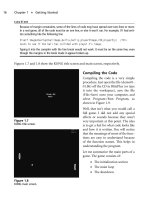Android Game Programming For Dummies ppt
Bạn đang xem bản rút gọn của tài liệu. Xem và tải ngay bản đầy đủ của tài liệu tại đây (35.43 MB, 387 trang )
www.it-ebooks.info
www.it-ebooks.info
Android
™
Game
Programming
FOR
DUMmIES
‰
www.it-ebooks.info
www.it-ebooks.info
by Derek James
Android
™
Game
Programming
FOR
DUMmIES
‰
www.it-ebooks.info
Android
™
Game Programming For Dummies
®
Published by
John Wiley & Sons, Inc.
111 River Street
Hoboken, NJ 07030-5774
www.wiley.com
Copyright © 2013 by John Wiley & Sons, Inc., Hoboken, New Jersey
Published by John Wiley & Sons, Inc., Hoboken, New Jersey
Published simultaneously in Canada
No part of this publication may be reproduced, stored in a retrieval system or transmitted in any form or
by any means, electronic, mechanical, photocopying, recording, scanning or otherwise, except as permit-
ted under Sections 107 or 108 of the 1976 United States Copyright Act, without either the prior written
permission of the Publisher, or authorization through payment of the appropriate per-copy fee to the
Copyright Clearance Center, 222 Rosewood Drive, Danvers, MA 01923, (978) 750-8400, fax (978) 646-8600.
Requests to the Publisher for permission should be addressed to the Permissions Department, John Wiley
& Sons, Inc., 111 River Street, Hoboken, NJ 07030, (201) 748-6011, fax (201) 748-6008, or online at http://
www.wiley.com/go/permissions.
Trademarks: Wiley, the Wiley logo, For Dummies, the Dummies Man logo, A Reference for the Rest of Us!,
The Dummies Way, Dummies Daily, The Fun and Easy Way, Dummies.com, Making Everything Easier, and
related trade dress are trademarks or registered trademarks of John Wiley & Sons, Inc. and/or its afliates
in the United States and other countries, and may not be used without written permission. Android is a
trademark of Google Inc. All other trademarks are the property of their respective owners. John Wiley &
Sons, Inc. is not associated with any product or vendor mentioned in this book.
LIMIT OF LIABILITY/DISCLAIMER OF WARRANTY: THE PUBLISHER AND THE AUTHOR MAKE NO
REPRESENTATIONS OR WARRANTIES WITH RESPECT TO THE ACCURACY OR COMPLETENESS OF
THE CONTENTS OF THIS WORK AND SPECIFICALLY DISCLAIM ALL WARRANTIES, INCLUDING WITH-
OUT LIMITATION WARRANTIES OF FITNESS FOR A PARTICULAR PURPOSE. NO WARRANTY MAY BE
CREATED OR EXTENDED BY SALES OR PROMOTIONAL MATERIALS. THE ADVICE AND STRATEGIES
CONTAINED HEREIN MAY NOT BE SUITABLE FOR EVERY SITUATION. THIS WORK IS SOLD WITH THE
UNDERSTANDING THAT THE PUBLISHER IS NOT ENGAGED IN RENDERING LEGAL, ACCOUNTING, OR
OTHER PROFESSIONAL SERVICES. IF PROFESSIONAL ASSISTANCE IS REQUIRED, THE SERVICES OF
A COMPETENT PROFESSIONAL PERSON SHOULD BE SOUGHT. NEITHER THE PUBLISHER NOR THE
AUTHOR SHALL BE LIABLE FOR DAMAGES ARISING HEREFROM. THE FACT THAT AN ORGANIZA-
TION OR WEBSITE IS REFERRED TO IN THIS WORK AS A CITATION AND/OR A POTENTIAL SOURCE OF
FURTHER INFORMATION DOES NOT MEAN THAT THE AUTHOR OR THE PUBLISHER ENDORSES THE
INFORMATION THE ORGANIZATION OR WEBSITE MAY PROVIDE OR RECOMMENDATIONS IT MAY
MAKE. FURTHER, READERS SHOULD BE AWARE THAT INTERNET WEBSITES LISTED IN THIS WORK
MAY HAVE CHANGED OR DISAPPEARED BETWEEN WHEN THIS WORK WAS WRITTEN AND WHEN IT
IS READ. FULFILLMENT OF EACH COUPON OFFER IS THE SOLE RESPONSIBILITY OF THE OFFEROR.
For general information on our other products and services, please contact our Customer Care
Department within the U.S. at 877-762-2974, outside the U.S. at 317-572-3993, or fax 317-572-4002.
For technical support, please visit www.wiley.com/techsupport.
Wiley publishes in a variety of print and electronic formats and by print-on-demand. Some material
included with standard print versions of this book may not be included in e-books or in print-on-demand.
If this book refers to media such as a CD or DVD that is not included in the version you purchased, you
may download this material at . For more information about Wiley
products, visit www.wiley.com.
Library of Congress Control Number: 2012950501
ISBN 978-1-118-02774-5 (pbk); 978-1-118-23599-7 (ebk); ISBN 978-1-118-26083-8 (ebk);
ISBN 978-1-118-22218-8 (ebk)
Manufactured in the United States of America
10 9 8 7 6 5 4 3 2 1
www.it-ebooks.info
About the Author
Derek James is the founder and owner of Polyclef Software, one
of the most successful Android indie game developers on Google
Play. His apps and games have garnered over 1 million combined
downloads, with multiple games receiving four-star or better rat-
ings and holding top-ranking positions in their categories for many
months. He was an early adopter of the Android platform and has
been developing Android apps and games since the first device
was released. He lives in Lafayette, Louisiana. You can follow
Derek on Polyclef’s Twitter feed (@polyclefapps), his blog
(), and his website
(polyclefsoftware.com).
www.it-ebooks.info
www.it-ebooks.info
Dedication
To Jenna, who was there by my side throughout the writing
of this book.
www.it-ebooks.info
www.it-ebooks.info
Author’s Acknowledgments
Thanks to Acquisitions Editor Kyle Looper for contacting me to
work on this book. I’m grateful for the opportunity.
Thanks for Project Editor Pat O’Brien for all the valuable and
timely feedback in helping get this book put together.
Jeremy Breaux provided invaluable feedback as technical editor,
helping to make sure that the code and examples worked well and
were clear.
Finally, thanks to Laurie, as well as my friends and family for being
supportive throughout the writing process.
www.it-ebooks.info
Publisher’s Acknowledgments
We’re proud of this book; please send us your comments at .
For other comments, please contact our Customer Care Department within the U.S. at 877-762-2974,
outside the U.S. at 317-572-3993, or fax 317-572-4002.
Some of the people who helped bring this book to market include the following:
Acquisitions, Editorial, and
Vertical Websites
Project Editor: Pat O’Brien
Acquisitions Editor: Kyle Looper
Copy Editor: Barry Childs-Helton
Technical Editor: Jeremy Breaux
Editorial Manager: Kevin Kirschner
Editorial Assistant: Leslie Saxman
Sr. Editorial Assistant: Cherie Case
Cover Photo: © iStockphoto.com / Cary Westfall
Cartoons: Rich Tennant (www.the5thwave.com)
Composition Services
Project Coordinator: Katherine Crocker
Layout and Graphics: Carrie A. Cesavice,
JoyceHaughey, Christin Swinford
Proofreaders: Melissa Cossell,
Shannon Ramsey
Indexer: BIM Indexing & Proofreading Services
Publishing and Editorial for Technology Dummies
Richard Swadley, Vice President and Executive Group Publisher
Andy Cummings, Vice President and Publisher
Mary Bednarek, Executive Acquisitions Director
Mary C. Corder, Editorial Director
Publishing for Consumer Dummies
Kathleen Nebenhaus, Vice President and Executive Publisher
Composition Services
Debbie Stailey, Director of Composition Services
www.it-ebooks.info
Contents at a Glance
Introduction 1
Part I: Adopting the Android Gaming Mindset 7
Chapter 1: Getting to Know Android Gaming 9
Chapter 2: Designing Your Game
27
Chapter 3: Setting Up Your Development Environment
51
Part II: Starting to Program 77
Chapter 4: Dissecting an Android App 79
Part III: Making Your First Game: Crazy Eights 109
Chapter 5: Creating a Simple Title Screen 111
Chapter 6: Creating a Basic Play Screen
135
Chapter 7: Finishing Your First Game
181
Part IV: Moving On to Your Second Game:
Whack-a-Mole 199
Chapter 8: Creating a Complex Title Screen 201
Chapter 9: Creating an Animated Play Screen
217
Chapter 10: Storing and Retrieving GameInformation
245
Part V: Managing Your Game in the Market 261
Chapter 11: Making Money with Your Game 263
Chapter 12: Publishing and Updating YourGame
277
Part VI:The Part of Tens 295
Chapter 13: Ten Open-Source Game Projects 297
Chapter 14: Ten Game Engines and Tools
307
Chapter 15: Ten More Places to Distribute Your Game
317
Chapter 16: Ten Websites for Android GameDevelopers
327
Glossary 339
Index 343
www.it-ebooks.info
www.it-ebooks.info
Table of Contents
Introduction 1
Why You Need This Book 1
Conventions Used in This Book 2
Technical Considerations 2
How This Book Is Organized 3
Part I: Adopting the Android Gaming Mindset 3
Part II: Starting to Program 4
Part III: Making Your First Game: Crazy Eights 4
Part IV: Moving On to Your Second Game: Whack-a-Mole 4
Part V: Managing Your Game in the Market 4
Part VI: The Part of Tens 5
Icons Used in This Book 5
Where to Go from Here 6
Part I: Adopting the Android Gaming Mindset 7
Chapter 1: Getting to Know Android Gaming 9
Seeing the Potential of the Android Platform 9
Where Android came from 10
And where it’s going 10
What You Must Know about the Mobile Gaming Industry 11
Handhelds and smartphones 11
iOS or Android 11
How Android Is Suited to Mobile Gaming 13
Growth 13
Freedom 14
Potential 14
Thinking Through Your Game Project 14
Designing rst 15
Following a structured development process 19
Deciding on distribution 20
Knowing What Tools You Need 21
Capitalizing on Your Game 22
The tried-and-true approaches 22
www.it-ebooks.info
Android Game Programming For Dummies
xiv
Chapter 2: Designing Your Game 27
Deciding What Kind of Game to Make 27
Genre 28
Number of players 29
Thinking about how and when people will play your game 31
Identifying Your Target Audience 34
The Android user base 35
Casting a wide net or nding a niche 36
Targeting Devices 37
Firmware 38
Hardware 39
Designing the interface and controls 43
Finding and/or creating resources (graphics and sound) 46
Chapter 3: Setting Up Your Development Environment 51
Starting at the Beginning 51
Downloading and Installing Eclipse 53
Installing the Software 57
Installing the SDK 57
Installing the ADT 58
Connecting Eclipse to the SDK 61
The Android Virtual Device (AVD) Manager 61
Creating a virtual device 62
Launching a virtual device 66
Creating an Android Project 67
Running an Android App 71
Manual launch control 71
Starting apps 73
Part II: Starting to Program 77
Chapter 4: Dissecting an Android App 79
Creating a New Project 79
Taking the Bird’s Eye View of a Project 83
Editing the Manifest 83
Naming and versioning your game 84
Targeting versions 85
Declaring activities 85
Setting permissions 86
Targeting different screen sizes 87
www.it-ebooks.info
xv
Table of Contents
Organizing Resources 88
Drawables 89
Layouts 91
Strings 93
Styles 94
Themes 94
Sounds 95
Organizing the Source Directory 95
Understanding Activities 97
The lifecycle of an activity 98
Using Views 101
Differences between View and SurfaceView 101
Instantiating a custom view 102
Drawing in a view 103
Handling input 106
Part III: Making Your First Game: Crazy Eights 109
Chapter 5: Creating a Simple Title Screen 111
Creating a Custom View 111
Loading the Title Graphic 113
Drawing the Title Graphic 115
Handling Screen Orientation 119
Controlling Screen Timeout 121
Making the Game Full-Screen 122
Adding buttons 124
Handling Button States 127
Launching the Play Screen 129
Intents 133
Bundles 134
Chapter 6: Creating a Basic Play Screen 135
Displaying Cards 135
Loading the card images 135
Dealing the cards 139
Displaying the game state 141
Taking Your Turn 152
Handling turns 152
Picking up cards 156
Playing cards 161
Showing dialog boxes (and toasts) 164
Taking cards from the draw pile 172
Advancing play 175
www.it-ebooks.info
Android Game Programming For Dummies
xvi
Chapter 7: Finishing Your First Game 181
Ending Hands and Games 181
Ending a hand 181
Ending a game 189
Wrapping Up the Game 192
Coding the opponent AI 192
Making your own launcher icon 195
Part IV
Moving On to Your Second Game: Whack-a-Mole 199
Chapter 8: Creating a Complex Title Screen 201
Using SurfaceView 202
Adding an Options Menu 212
Toggling the Sound Option 213
Chapter 9: Creating an Animated Play Screen 217
Handling Images for the Play Screen 217
Making Simple Animations 223
Handling User Interaction 228
Loading and Playing Sounds 234
Handling End of Game 239
Chapter 10: Storing and Retrieving GameInformation 245
Using Shared Preferences for Data Storage 246
Using XML for Data Storage 249
Using a SQLite Database for Data Storage 253
Part V: Managing Your Game in the Market 261
Chapter 11: Making Money with Your Game 263
Knowing Your Competition 263
Monetization Models 269
Free 269
Paid 270
Free-to-Paid 272
Ad-based 274
In-app Purchases 275
Alternatives to Google Play 276
www.it-ebooks.info
xvii
Table of Contents
Chapter 12: Publishing and Updating YourGame 277
Creating a developer account for Google Play 277
Generating a Key with Keytool 278
Exporting a Signed Application 279
Uploading Your Game to Google Play 282
Uploading the APK 283
Adding product details 284
Supporting and Updating Your Game After Publication 292
Part VI: The Part of Tens 295
Chapter 13: Ten Open-Source Game Projects 297
Lunar Lander 297
Replica Island 299
Alien Blood Bath 299
OpenSudoku 300
Lexic 301
Newton’s Cradle 302
Vector Pinball 303
asqare 303
tiltmazes 304
GL ES Quake 305
Chapter 14: Ten Game Engines and Tools 307
libgdx 308
AndEngine 309
Unity 309
OpenFeint 310
Flurry 310
Audacity 311
sfxr 312
GIMP 313
Inkscape 314
AdWhirl 314
Chapter 15: Ten More Places to Distribute Your Game 317
Amazon 318
Handango 319
Opera Mobile App Store 320
GetJar 321
SlideME 322
Appoke 323
www.it-ebooks.info
Android Game Programming For Dummies
xviii
AppBrain 324
AndroLib
325
Your Website
326
BitTorrent Sites
326
Chapter 16: Ten Websites for Android GameDevelopers 327
Stack Overow 328
Android Developer
329
anddev.org
330
Android Developers Blog
331
Appolicious
332
Android Tapp
333
Phandroid
334
xda developers
335
Droid Gamers
336
Android and Me
337
Glossary 339
Index
343
www.it-ebooks.info
Introduction
T
here’s something special about games. The best games, the ones we
remember, don’t just relieve our boredom from time to time. They teach
us new things, stretch our brains, or make us feel happy, excited, and some-
times angry! Social games can even bring us closer to our friends and family.
We all have games that we think of fondly, that added something to our lives.
Now, with the advent of smartphones, we can carry that experience around
in our pockets and purses.
I still remember when my parents hooked up our first video game, Pong, to
the family television. At the time that luminescent “ball” traversing the blurry
screen was the coolest thing I’d ever seen. I’ve played a lot of games on a lot
of platforms in the intervening years, but when my friend Philip gifted me
with the first Android phone, the G1, I was skeptical that it would make a very
good gaming platform. Who wants to play games by staring at a tiny screen
on a device whose primary function is to make phone calls? Then again, the
iPhone had by that time already proven that people were not only willing to
play games on their smartphones, they were absolutely ravenous for games
on their smartphones.
When the Android market launched, it took a little while to get some traction.
I developed and published some of the first games on the market, when not
many other developers were flocking to the platform. The G1 was a clunky,
first-generation device, they said. It’ll never compete with the iPhone, they
said. Open platforms are never good for gaming, they said. Well, I was able
to make enough games that generated enough income to let me develop for
Android full-time. And the platform has come a long way in the meantime;
now Google doesn’t have a problem attracting game developers.
When I was approached to write this book, I jumped at the chance to write
about a subject that blends my two passions of gaming and programming. I’m
guessing you share those passions as well, and want to make cool, compel-
ling games. I’m going to help you make that happen.
Why You Need This Book
Obviously you want to make games for Android, but you may not know
where to get started. You may not even have any programming experience —
if you do, great! — but I don’t make too many assumptions about your level
www.it-ebooks.info
2
Android Game Programming For Dummies
of experience. By default, Android apps are written in Java. All the examples
in this book are also in Java, so it’s helpful, but not necessary, to have some
working knowledge of Java. However, even someone with little or no experi-
ence should be able to work through this book.
By the end, you’ll have a good understanding of Android, two complete,
working and playable games, and a solid foundation for developing and pub-
lishing your own games. Along the way, I also talk a bit about how you might
get more downloads and actually make money from your games. If any or all
of that interests you, this book is a great place to start.
Conventions Used in This Book
Code examples are all in the Java programming language. Android also uses
XML files to define layouts and preferences in projects. I use a monospaced
font to show examples of the content that lurks in these types of files. The
idea is to set the examples apart from other text; they look like this:
System.out.println(“Hello”);
Java and XML are case-sensitive (it matters whether letters are capitalized),
so be sure to capitalize letters in any code example from the book exactly as
you see them. If you don’t, you’ll see compile errors in Eclipse.
URLs for websites will also appear in monospaced font
If you are ever confused about the contents of a given file in any of the proj-
ects discussed in this book, you can always refer to the actual source files
here:
www.dummies.com/go/androidgameprogramming
Technical Considerations
To develop games for Android, you need a PC running a version of either
Linus, Windows, or Mac OS that meets the requirements for both the Android
SDK and the Java Development Kit (JDK). Both the SDK and JDK are freely
available from their respective websites, where you can find more detail
about specific system requirements:
www.it-ebooks.info
3
Introduction
/> />index.html
Android also uses the Eclipse IDE (integrated development environment),
which we will be using throughout this book. Installation of all this software
is covered in Chapter 3.
As I stated earlier, a working knowledge of Java and XML are helpful, but
not necessary. If you’re familiar with any high-level language and develop-
ment environment, you should be fine. If not, you should still be able to work
through the examples and put together workable games, but you’ll likely
have a bit more of a tussle.
If you’re interested in developing for Android, you probably have an Android
device, but you don’t necessarily need one. The Android SDK provides an
emulator which lets you configure virtual devices to test your games without
the actual hardware.
But testing playability without actual devices is not advised. Especially if
you’re designing for multiple form factors, such as both phones and tablets,
you’ll probably want to invest in at least a couple of test devices.
How This Book Is Organized
Android Game Programming For Dummies is divided into six parts. The follow-
ing section describes the contents of each part.
Part I: Adopting the Android
Gaming Mindset
Part I provides you with a history of Android and mobile gaming to this point
in time. I contrast Android game development with other platforms and dis-
cuss its pros and cons. This part also helps you think through all the neces-
sary decisions before you begin to program, including the basics of designing
a mobile game for Android.
www.it-ebooks.info
4
Android Game Programming For Dummies
Part II: Starting to Program
Part II walks you through setting up your development environment and
installing all the necessary frameworks and tools for building Android games.
I show you how to create a simple Android project and run the resulting
app on both virtual and real devices. I then walk you through the guts of an
Android project to get a closer look at what all the pieces are and how they
all fit together to make a game.
Part III: Making Your First
Game: Crazy Eights
Part III involves making your first game, the two-player card game Crazy
Eights. You create a title screen, load and display graphics, and implement UI
elements such as buttons. You implement all the elements for a card game,
including such tasks as loading, shuffling, and dealing a virtual deck of cards.
You implement all the logic for playing cards and taking turns, and also con-
jure up a computer opponent to play against. By the end of this part, you’ll
have a complete, playable card game for Android.
Part IV: Moving On to Your Second
Game: Whack-a-Mole
Part IV shows you how to make a second complete game, Whack-a-Mole. I use
a different approach than our first game that’s slightly more complex, but
provides the additional rendering speed we need for real-time arcade games.
I cover how to generate simple animations and how to load and play sounds
in response to events in the game. I also show you how to store and retrieve
data, allowing you to manage game states between sessions. By the end of
this part, you’ll have a second complete playable game.
Part V: Managing Your
Game in the Market
Part V discusses how to make money from your game, if that interests you.
I also discuss the nuts and bolts of exporting and digitally signing your
game for upload to Google Play. I walk you through the process of creating
an uploadable application file, but also all the promotional resources you’ll
www.it-ebooks.info
5
Introduction
need for the market listing. I then show you how to upload your game to the
market and update it when it’s there.
Part VI: The Part of Tens
Part VI provides you with some handy resources to help you develop your
own games while working through this book and moving beyond it. I dis-
cuss some intriguing open-source game projects that cover genres and
approaches that the two sample games here don’t cover — such as side-
scrolling platformers and word games. Then I point you to game engines
you can leverage to save you lots of time, and point out some features like
physics engines that handle chores like gravity and movement and would
take months to implement otherwise. I also talk about free tools to help you
create your own graphics and sound resources, as well as frameworks to
help you promote and monetize your game.
Icons Used in This Book
This icon indicates useful information you should pay attention to.
This icon represents important overriding concepts that frame all the content
in a particular section.
This icon indicates information that dives a bit deeper into the technical
aspects of a particular subject. Usually it’s not essential to your understanding
of the associated material, but is provided to give you a better handle on the
topic.
This icon points out potential problems you might encounter when you’re
dealing with a particular aspect of development. Pay particular attention to
these and try to avoid these pitfalls when possible.
These links connect you to valuable internet resources.
www.it-ebooks.info









